Copyright 2017 by Vincenzo Marianella and James O. Fraioli Photographs copyright 2017 by Jessica Nicosia-Nadler, except for . All rights reserved. No part of this book may be reproduced in any manner without the express written consent of the publisher, except in the case of brief excerpts in critical reviews or articles. All inquiries should be addressed to Skyhorse Publishing, 307 West 36th Street, 11th Floor, New York, NY 10018. Skyhorse Publishing books may be purchased in bulk at special discounts for sales promotion, corporate gifts, fund-raising, or educational purposes.
Special editions can also be created to specifications. For details, contact the Special Sales Department, Skyhorse Publishing, 307 West 36th Street, 11th Floor, New York, NY 10018 or . Skyhorse and Skyhorse Publishing are registered trademarks of Skyhorse Publishing, Inc., a Delaware corporation. Visit our website at www.skyhorsepublishing.com. 10 9 8 7 6 5 4 3 2 1 Library of Congress Cataloging-in-Publication Data Names: Marianella, Vincenzo, author. (Cookbook author), author. (Cookbook author), author.
Title: The New Bloody Mary: more than 75 classics, riffs & contemporary recipes for the modern bar / Vincenzo Marianella and James O. Fraioli; Creative Consultant Christina Kindwall; Photography by Jessica Nicosia Nadler; Styling by Le Cordon Bleu College of Culinary Arts, Sacramento, California. Description: New York : Skyhorse Publishing, 2017. | Includes index. Identifiers: LCCN 2016047555| ISBN 9781510716681 (hardback) | ISBN 9781510716698 (ebook) Subjects: LCSH: Bloody Marys (Cocktails) | BISAC: COOKING / Beverages / Wine & Spirits. | COOKING / Specific Ingredients / Herbs, Spices, Condiments. | LCGFT: Cookbooks. | LCGFT: Cookbooks.
Classification: LCC TX951 .M2637 2017 | DDC 641.87/4dc23 LC record available at https://lccn.loc.gov/2016047555 Cover design by Brian Peterson Cover photo credit by Jessica Nicosia-Nadler Printed in China  ACKNOWLEDGMENTS The authors would like to greatly acknowledge the following people for their generous support and assistance with this book: All of the contributing bartenders, mixologists, bloggers, bars, and restaurants. Without your unbelievable support and assistance, this book would not be possible; Christina Kindwall for your countless hours of research, persistence, and dedication; Photographer Jessica Nicosia Nadler; The extraordinary culinary team at Le Cordon Bleu College of Culinary Arts, Sacramento, California: Chef John Hall M. Ed; Chef Vincent Paul; Alexander C.E.C., Chef Adrian Day; Murchison, Meghan Leeman, D. W. Herold, David Nadler, Gary Flora, Raymond Cordell; The editorial team at Skyhorse Publishing; Agent Sharlene Martin of Martin Literary & Media Management.
ACKNOWLEDGMENTS The authors would like to greatly acknowledge the following people for their generous support and assistance with this book: All of the contributing bartenders, mixologists, bloggers, bars, and restaurants. Without your unbelievable support and assistance, this book would not be possible; Christina Kindwall for your countless hours of research, persistence, and dedication; Photographer Jessica Nicosia Nadler; The extraordinary culinary team at Le Cordon Bleu College of Culinary Arts, Sacramento, California: Chef John Hall M. Ed; Chef Vincent Paul; Alexander C.E.C., Chef Adrian Day; Murchison, Meghan Leeman, D. W. Herold, David Nadler, Gary Flora, Raymond Cordell; The editorial team at Skyhorse Publishing; Agent Sharlene Martin of Martin Literary & Media Management.  CONTENTS
CONTENTS  INTRODUCTION The old saying as American as apple pie is often used to illustrate something familiar and something comfortable.
INTRODUCTION The old saying as American as apple pie is often used to illustrate something familiar and something comfortable.
It could also be used to express a reflection of our societal ingenuity, independence, and our historyand lets face it, it also speaks to our gluttonous yet remedial nature. Perhaps the saying should actually be as American as a Bloody Mary, since this iconic cocktail really is a blend of a little bit of our history, seasoned with a variety of regional and ethnic influences, shaken or stirred to create the most adaptable cocktail the world has ever known, yet it remains as American as apple pie. Something about a Bloody Mary conjures up nostalgic feelings of relaxation, exploration, and remediation. The Bloody Mary is something truly remarkable. It is one of those cocktails that is time-tested yet so unique and special that many bartenders and mixologists feel theyve been given a blank canvas in which to be creative, offering the consumer an alcoholic beverage that can be modified or specifically tailor-made to suit particular taste preferences. From an endless array of garnishes and condiments, to a variety of spirits including vodka, gin, beer, rum, and tequila, the Bloody Mary is as varied as the imagination allows.
Virtually endless flavor profiles are created with each new combination. Then, of course, there are those who simply prefer the traditional Bloody Mary without any alteration. The choice is entirely up to the individual requesting the drink. As for the bartenders and mixologists crafting what many consider to be the most popular cocktail in America, it is also their nature to try and fully understand each beverage, its history, and ultimately, its intention. To fully understand the Bloody Mary cocktail, learn of its origin, and how it has evolved throughout the years, is really to understand a lot about who we are as a society. The Bloody Mary is a little more than eighty years old, yet the tales and lore behind its origin are just as murky and mysterious as the libation itself.
There are many colorful theories, some more disputed than others, for exactly who created the drink and when. We do know, however, that Paris, Prohibition, the Russian Revolution, Hollywood, and Hemingway are all key players in creating the Bloody Mary we know and admire today. The year is 1911, and American jockey Ted Sloan appoints Scotsman Harry MacElhone to run a bar in Paris named Harrys New York Bar at 5 Rue Danou. Ted procured the site built around his favorite New York bar, which he had dismantled and sent by boat to Paris to create an authentic American bar as a way of preserving his favorite watering hole as Prohibition loomed in the States. An authentic New York-style bar became a novelty as liquor-deprived Americans, including servicemen and American celebrities such as Rita Hayworth, Ernest Hemingway, and Humphrey Bogart sought refuge at Harrys in Paris when Prohibition went into in full swing in the United States by 1920. As legend has it, the words Sank Roo Doe Noo were written on Harrys of Paris because that is what limited French-speaking Americans would tell the Parisian taxi drivers where to take them soon as they stepped off the plane.
At the same time, the Russian Revolution had dismantled the czarist autocracy and was leading to the rise of the Soviet Union, which sent migrs fleeing Russia into France. Vladimir Smirnov, who took over his fathers vodka company, was one of those who fled Russia, taking up residence in France, where he popularized vodka. Meanwhile, Ferdinand Pete Petiot experimented with vodka while bartending at Harrys bar. Back in the United States, many brands were trying to capitalize on Prohibition by offering cocktail-deprived Americans with something to take their place. In the 1930s, Lea & Perrins printed their recipe for Tomato Juice Cocktail, which was a combination of tomato juice mixed with Lea & Perrins sauce and served ice-cold. It is believed at that time, back in France, that Petiot was introduced to this Tomato Juice Cocktail in a can and thought it could breathe life into his vodka, which he described as a tasteless spirit.
Yet, when he combined vodka with tomato juice and spices, something magical happened. That magic, many believe, resulted in the birth of the Bloody Mary. There are also many theories for how the name Bloody Mary came to be. One of the most popular theories is that Petiot, who was born in England, named the drink after Queen Mary Tudor of England. Apparently, Queen Marys Bloody Mary moniker came from her acts as queen in support of Catholicism, which killed hundreds of Protestants during the Marian Persecutions due to the Heresy Acts of 1554. Another popular theory for how the name originated is that American entertainer Roy Barton often frequented a dark and shady Chicago bar in the 1900s called the Bucket of Blood, named for all the blood mopped up from the floor after fights broke out.





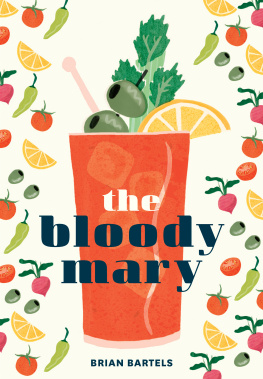
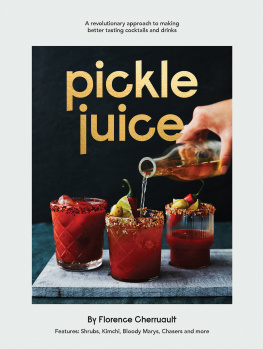
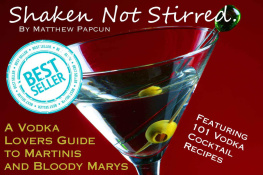

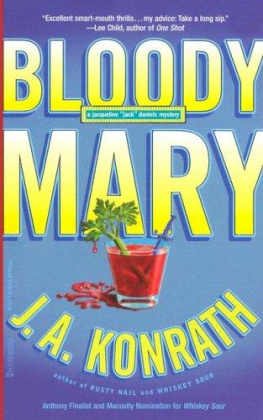
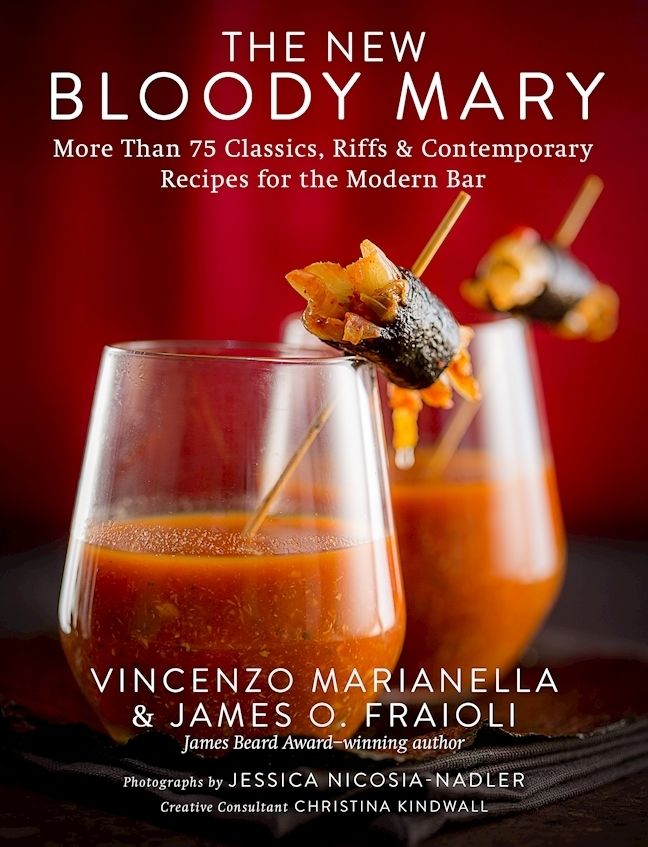


 ACKNOWLEDGMENTS The authors would like to greatly acknowledge the following people for their generous support and assistance with this book: All of the contributing bartenders, mixologists, bloggers, bars, and restaurants. Without your unbelievable support and assistance, this book would not be possible; Christina Kindwall for your countless hours of research, persistence, and dedication; Photographer Jessica Nicosia Nadler; The extraordinary culinary team at Le Cordon Bleu College of Culinary Arts, Sacramento, California: Chef John Hall M. Ed; Chef Vincent Paul; Alexander C.E.C., Chef Adrian Day; Murchison, Meghan Leeman, D. W. Herold, David Nadler, Gary Flora, Raymond Cordell; The editorial team at Skyhorse Publishing; Agent Sharlene Martin of Martin Literary & Media Management.
ACKNOWLEDGMENTS The authors would like to greatly acknowledge the following people for their generous support and assistance with this book: All of the contributing bartenders, mixologists, bloggers, bars, and restaurants. Without your unbelievable support and assistance, this book would not be possible; Christina Kindwall for your countless hours of research, persistence, and dedication; Photographer Jessica Nicosia Nadler; The extraordinary culinary team at Le Cordon Bleu College of Culinary Arts, Sacramento, California: Chef John Hall M. Ed; Chef Vincent Paul; Alexander C.E.C., Chef Adrian Day; Murchison, Meghan Leeman, D. W. Herold, David Nadler, Gary Flora, Raymond Cordell; The editorial team at Skyhorse Publishing; Agent Sharlene Martin of Martin Literary & Media Management.  CONTENTS
CONTENTS  INTRODUCTION The old saying as American as apple pie is often used to illustrate something familiar and something comfortable.
INTRODUCTION The old saying as American as apple pie is often used to illustrate something familiar and something comfortable.